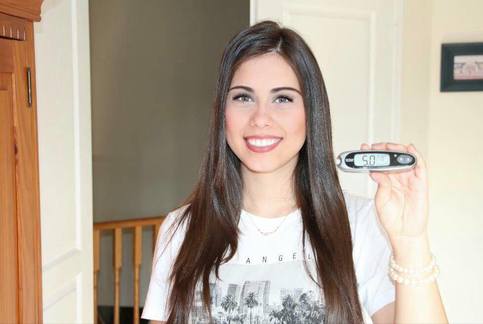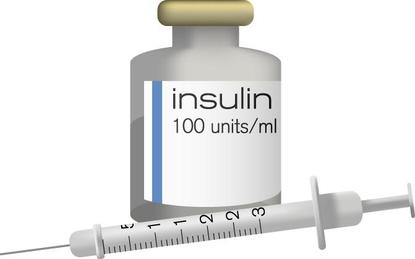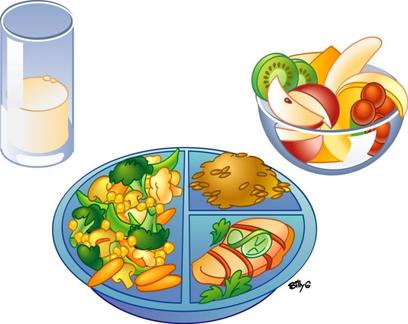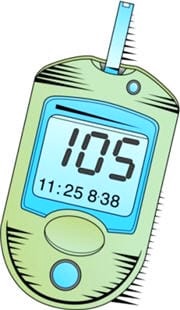What Is Diabetes?
|
Holding my glucometer showing my 5.0 mmol/L blood glucose level
|
What is diabetes? I get this question asked on a daily basis. Many know that it is a lifelong disease, but many are also unaware of its severity. I have created this blog as a way to educate people on what diabetes is and how it can be controlled. My goal is to possibly save a diabetic’s life through the education this blog will contain in each week’s post. I know that I have struggled for help while having a low blood sugar and not one person knew what to do. Therefore, I want to educate individuals on what the similarities and differences of each type of diabetes are, their symptoms, how to control each type, the new technologies that have evolved to control diabetes, the myths and truths of living with this disease, among others. Due to this topic being very close to my heart, I will include photos of myself as a way to also tell my story through my blogging.
Diabetes mellitus is categorized by a group of diseases in which a person’s blood glucose is high due to the lack or insufficiency of insulin being produced in the pancreas. These are categorized by type 1 diabetes and type 2 diabetes. In order to understand the similarities and differences between each, I will explain each one of these in detail below. |
Diabetes Type 1:
|
Diabetes type 1, also known as juvenile diabetes or insulin-dependent diabetes, is an autoimmune and chronic condition in which a person's pancreas produces no insulin. Insulin is a hormone created by the pancreas that is needed to allow glucose to enter body cells from the bloodstream to produce energy. Therefore, type 1 diabetics have to mainly rely on insulin therapy.
Insulin therapy includes mainly two types of insulin solutions: fast acting (Novolin R. or Humulin R.) and slow acting (Lantus, Levemir or Toujeo), although intermediate acting is also available (NPH). Both types of insulin, fast and slow/intermediate acting, are required for type 1 diabetics on a daily basis. Slow or intermediate acting insulin is taken once to twice a day - same doses every day, when fast acting is taken every time a diabetic eats or needs an insulin correction. Therefore, diabetics have to calculate the carbohydrates they eat and inject insulin (20 minutes before eating) according to each person's carb to insulin ratio on each meal. For example, my carb to insulin ratio is 10:1 = for each 10 carbohydrates I eat, I will take 1 unit (0.01 mL) of insulin. The ratio of each diabetic varies, therefore, the reaction and sensibility to each unit of insulin is different for every person. |
"Insulin is a hormone that helps your body to control the level of glucose (sugar) in your blood. Without insulin, glucose builds up in your blood instead of being used for energy " |
|
Diabetes Type 2:
|
re Type 2 diabetes, also called adult-onset diabetes or non-insulin dependent diabetes, is a disease in which a person's pancreas does not produce enough insulin; or a person's body cells do not properly use the insulin it makes, (Canadian Diabetes Association). Type 2 diabetes is the most common and it may be caused through a combination of genes and extra weight. It can also be developed at ANY age - DNA may affect the way your body may use the insulin it produces, however, being overweight can also cause your body cells to develop insulin resistance.
This type of diabetes is the most common in society today. Symptoms vary from person to person, and low blood sugar episodes or hypoglycemias are often uncommon, unless the person is treating with insulin or other diabetes medicines. Unlike type 1 diabetes, type 2 diabetes is controlled through good/healthy dieting, regular exercise and by taking blood glucose lowering medications (normally pills but may include insulin as well). Type 2 diabetes can also be prevented or delayed with a healthy lifestyle. That being said, when type 2 diabetes is treated, blood glucose, blood pressure, cholesterol levels and weight will lower. Though each type of diabetes is controlled differently, people with either type are still responsible for calculating the carbohydrates that will be eaten in each meal, and from there, taking further action to control their blood glucose levels. |
Ideal Blood Glucose Levels: Due to the insulin injections or pills diabetics have to take throughout the day, their blood sugar levels may get low or high. Hypoglycemias (low blood glucose) most often happen when a diabetic takes way too much insulin/lowering medication for the amount of carbohydrates eaten. It may also occur when a diabetic has not eaten for a long period of time. Similarly, hyperglycemias (high blood glucose) arise when not enough insulin/lowering medication is taken in comparison to the amount of carbohydrates eaten. However, high blood glucose levels may occur when emotions are running high, such as shock and stress, or when sick.
The American Diabetes association states that an ideal blood glucose level on a diabetic before a meal should be between 70 and 130 mg/dl, (Living With Diabetes, para. 1). However, in Canada, the ideal blood glucose levels for a diabetic are between 4.0 to 8.0 mmol/L. |
My Personal Experience Living With Type 1 Diabetes:
|
As I am a type 1 diabetic, it is easier for me to explain how this type of diabetes functions. Although I control myself as best as I possibly can, it is still hard to manage at times. My blood glucose control is great, but I do still get hypo/hyperglycemias here and there. Blood glucose levels may change according to your stress, insulin injections, daily activities, among others. Therefore, any type of diabetes is a daily struggle. It is a disease that you will be living with for the rest of your life (as of now). Consequently, I have decided to control my diabetes as best as possible and I hope to inspire others to do the same! More information to come in next week's post. Thank you for reading!
|












